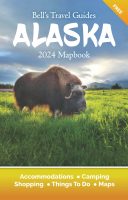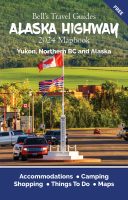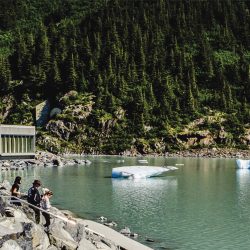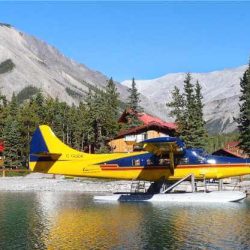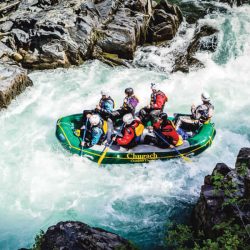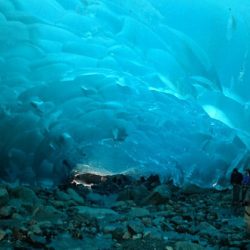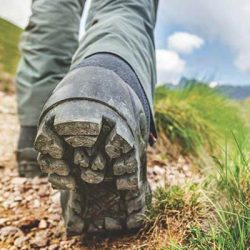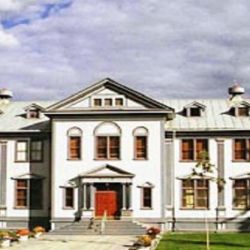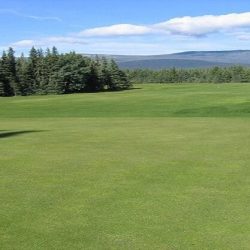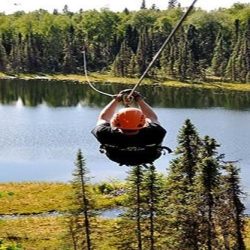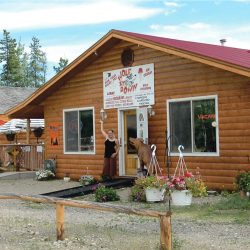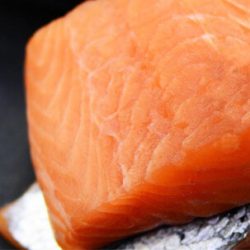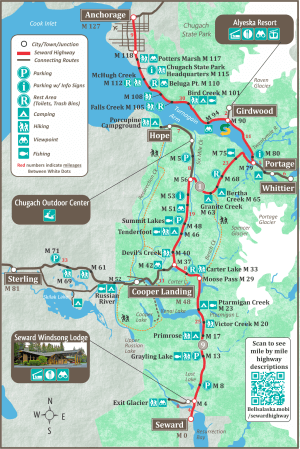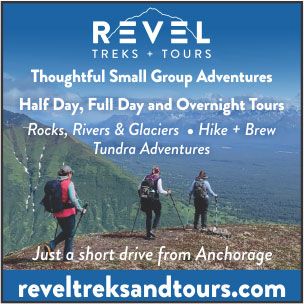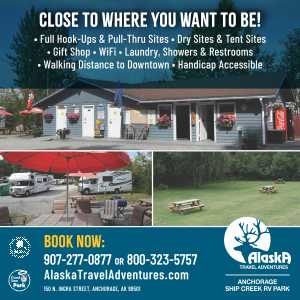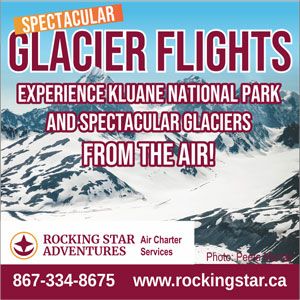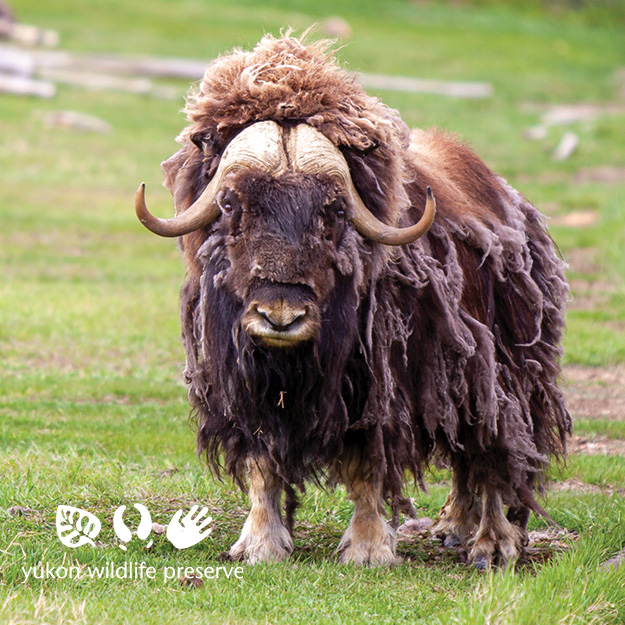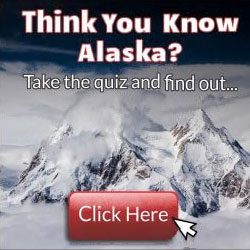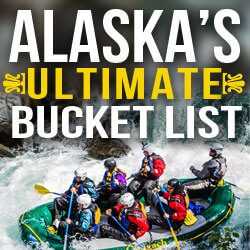The 127 mile/204 km Seward Highway has been designated a National Forest Scenic Byway. It connects the cities of Anchorage to Seward traveling past salt water bays, ice-blue glaciers, and alpine valleys. The first 50 miles of the highway twists and turns along the base of the Chugach Mountains, the Chugach National Forest and the shores of Turnagain Arm.
The 37-foot tides of Turnagain Arm are exceeded only by those in Nova Scotia’s Bay of Fundy. The waters racing out of the inlet expose miles of mud flats and when they return, frequently create a 6-foot bore tide. These bore tides are highest during the equinox and when a very low tide is followed by a very hightide. If your timing is good, you may even see people surfing or kayaking the bore tide for miles!
Just past the Portage Glacier Road (Mile 79), you will enter the Kenai Peninsula Borough – over 25,000 square miles of scenic park lands, glaciers, rivers, and unique communities. Here it is easy to try your luck at hooking a world record king salmon or a giant halibut, photograph a Russian church, or view sea lions & whales on a scenic cruise, all on the same day! Mile 79 is also where you will find the Alaska Wildlife Conservation Center.
Most of the Seward Highway passes through the Kenai Mountains-Turnagain Arm National Heritage Area. This heritage area includes mountains, lakes, rivers, fjords and small communities with cultural and historic significance to the nation. The Kenai Mountain-Turnagain Arm National Historic Area stretches from Girdwood to Seward and includes Whittier, Portage, Hope and Cooper Landing.
37 miles north of Seward, the Seward Highway connects with the Sterling Highway which travels southwest to the end of the Kenai Peninsula and accesses the towns of Soldotna, Kenai, Ninilchik, Anchor Point, and Homer.
When you reach Seward, at the end of the highway, you will be met with stunning scenery from this small coastal community. It is known as the gateway to Kenai Fjords National Park and a number of local tour companies will share with you the stunning natural scenery and amazing wildlife found in the park. Visit Kenai Fjords Tours or Major Marine Tours to book an unforgettable adventure.
You’ll get updates on road conditions and construction at http://511.alaska.gov
The Train From Anchorage to Seward
The Alaska Railroad parallels the Seward Highway to Portage, where it has a branch line to Whittier Alaska (port for the Alaska Marine Highway Ferry System and Cruise Port for Anchorage). The Alaska Railroad is also one of the most popular ways to travel from Anchorage to Seward. It is possible to take the Alaska Railroad to Seward for a day trip, but it is recommended you plan to stay at least 1 or 2 days in Seward. The train will arrive in Seward in time for a boat tour of Kenai Fjords National Park, before returning to Anchorage in the evening.
Whittier and Portage
The Portage Glacier Road is at Mile 79 of the Seward Highway. It is 5 miles to Portage and the Begich Boggs Visitor Center. From the parking lot, you will be able to see icebergs floating in Portage Lake. You can no longer see Portage Glacier from the Visitor Center, so we suggest taking a tour with Portage Glacier Cruises, one of the most popular glacier cruise in Alaska.
If you decide to drive the short distance into town of Whittier, you will pass through the Anton Anderson Memorial Tunnel. At 2.5 miles, this is the longest tunnel in North America that allows both trains and vehicles to share the tunnel. Thankfully, on an alternating schedule!
Whittier is known as a gateway to Prince William Sound, with is beautiful protected waters, stunning glaciers and incredible marine wildlife viewing. There are a number of glacier cruises and boat tours in Whittier that will take visitors out to experience this natural wonder. Be sure to check out Lazy Otter Charters in Whittier.
Warning: The mudflats along the coast from Anchorage to Portage (Turnagain Arm) exhibit quicksand-like conditions. It is extremely dangerous to walk on the beach or mudflats in this area.
For a complete list of Things to do in Alaska, visit our Things To Do section. For information on places to camp, visit our section on camping in Alaska. To determine when you should plan your trip to Alaska, visit our page on the best time to visit Alaska. Finally, many visitors to the north want to experience the Northern Lights, so we’ve put together a page of detailed information on how and when to see the Northern Lights.
Seward Highway Driving Highlights
Mile markers for the Seward Highway start at the very beginning of downtown Seward (Mile 0), near the Alaska SeaLife Center and end in Downtown Anchorage (Mile 127). You will reach the outskirts of Anchorage at Mile 120. Most people driving the Highway from Anchorage to Seward for the first time will be driving to Seward so the mile markers will count down to mile 0.
Beluga Point Lookout (Mile 110.3).
Beluga Point is a popular stopping point on the drive from Anchorage to Seward. It got it’s name because of the large number of Beluga Whales that are commonly spotted in the area. There are over 300 Beluga Whales that inhabit Cook Inlet and Turnagain Arm from mid-July to August.
The viewpoint at Beluga point has spectacular, uninterrupted views of Turnagain Arm, where you may also spot Bald Eagles soaring overhead in search of salmon. The parking lot has information signs, a beluga sculpture and telescopes for spotting the whales in the distance.
Windy Corner (Mile 106.8).
Windy corner is known as one of the best places to spot Dall Sheep in all of Alaska. The high rock faces at the edge of the road are often full of sheep, perched in precarious spots along the cliff walls, grazing. Occasionally, the sheep will come all the way down to the side of the road. If you do spot Dall sheep, pull over at the nearest pullout.
Bird Creek Campground (Mile 100.8).
This campground is in the Chugach State Park and has 22 sites for RVs and tents. It connects with the paved, multi use trail to Girdwood. There is water, picnic tables and toilets.
Bird Point (Mile 96.5).
Bird Point is another great place to stop and enjoy the views over Turnagain Arm. Watch for Beluga Whales out in the water. They tend to come in with the tide to feed on the salmon, so a few hours before high tide is your best chance of spotting them. There is also a paved, multi use trail that connects to Girdwood, 6 miles south. This is also one of the best places to watch the bore tide. You can check the tide schedule to determine the best time to view this amazing natural phenomenon.
Alyeska Resort and Tram (In Girdwood at Mile 90)
The Tram at Alyeska Resort is short ride to a viewing deck at 2300 ft. With breathtaking panoramic views of mountains, hanging glaciers and an abundance of wildlife. In the Summer months Alyeska is a destination for its scenic vistas, while in the winter the Alyeska Ski Resort is most developed ski resort in all of Alaska.
The Alaska Wildlife Conservation Center (at Mile 79)
AWCC is a non-profit sanctuary dedicated to preserving Alaska’s wildlife through conservation, education and research. The sanctuary maintains over 200 acres of spacious habitats for resident animals to feel at home displaying their natural wild behavior as education ambassadors for their species. It is common for visitors to see black bears, brown bears, moose, wood bison, muskox, wolves, porcupines, and more.
Hope Alaska (Mile 56)
At mile 56, take the 16 mile road to Hope and discover one of Alaska’s oldest gold rush towns.
Moose Pass (Mile 29)
Moose Pass is a small community of 300 on the Seward Highway. It is a haven for outdoor enthusiasts who love hiking and backpacking. It is near Johnson Pass Trail, Carter Lake Trail, Victor Creek Trail and Ptarmigan Creek Trail. Moose Pass has a lodge with a restaurant and gift shop.
Exit Glacier (Mile 3.5)
Turn on Herman Leirer Road (Also known as Exit Glacier Road). Drive 8.4 miles to Exit Glacier, which is the only part of the Kenai Fjords National Park that is accessible by car. You can also stay near Exit Glacier at the Seward KOA Campground.
If you are looking for Glacier Ice Caves to explore, here are some ice caves near Seward highway.
How long is the drive from Anchorage to Seward
The drive from Anchorage to Seward is 127 miles but It’s actually only 119 miles to reach the southern outskirts of Anchorage. the last 8 miles of the Seward Highway double as one of the main traffic arteries of the city of Anchorage.
Is the Seward Highway Paved
Yes the Seward Highway is Paved the entire way. There are also plenty of passing lanes in both directions, making it one of the easiest highways in Alaska to drive. It has wide paved shoulders for most of the way as well.
What is the best way to get from Seward to Anchorage?
The two most common ways to get from Seward to Anchorage are by car or on the Alaska Railroad. Many visitors arrive in Seward by cruise ship and decide to travel to Anchorage and Denali National Park. The drive is easy and if you don’t have your own vehicle, you can rent from Hertz in Seward. They offer one way rentals between Seward and Anchorage.
The Alaska Railroad is also a very easy way to get from Seward to Anchorage. The train leaves everyday during the summer. The train parallels the Seward Highway at times, but also takes a slightly different route that offers spectacular scenery. You can stop in Portage and take the train to Whittier or Spencer Glacier.
Is Seward worth visiting?
Yes, absolutely Seward Alaska is worth visiting. It is one of the most beautiful cities in Alaska. It is also the gateway to the Kenai Fjords National Park. You can hike on a glacier, at Exit Glacier, which is a very Alaskan activity.
Can I get from Seward to Anchorage without a car?
Yes, the Alaska Railroad is a great way to get from Seward to Anchorage if you don’t want to drive. There are also coach service during the summer with the Park Connection Motorcoach.
Seward Highway Map
The map of the Seward Highway shows the abundant recreation areas along the highway. Between Anchorage and Girdwood there are dozens of scenic viewpoints overlooking Turnagain Arm. At Girdwood, you can take the short side trip up to the Alyeska Resort and Aerial Tram.
Only 11 miles further south on the Seward Highway is Portage Recreation Area. This is also where you will find the Alaska Wildlife Conservation Center, one of the best opportunities to view wildlife in Alaska.
At Portage, you can turn off the Highway and and drive to Whittier via two tunnels. The Whittier tunnel is the 2nd longest in North America.
After Portage and Whittier, the next worthwhile side trip is the road to Hope at mile 56. Hope is a former gold rush town and existed even before Anchorage was founded. The Hope road is also where you will find Chugach Outdoor Center, a premier rafting company sure to give you a thrill.
